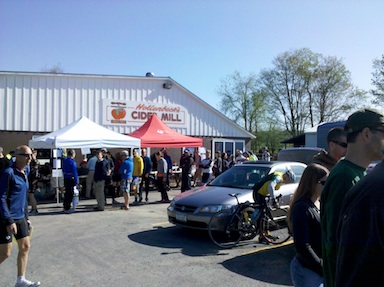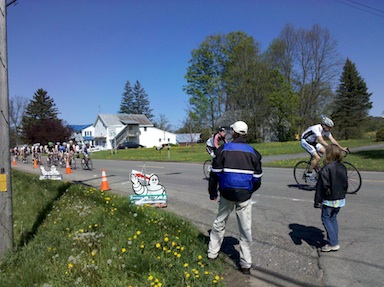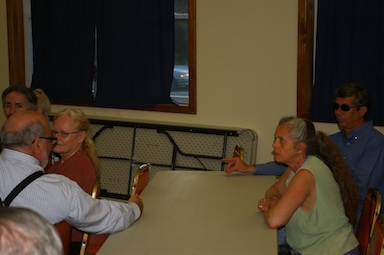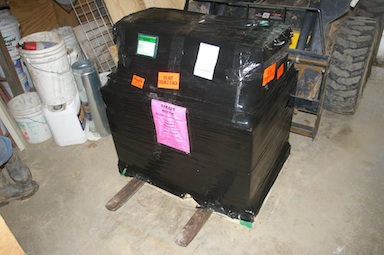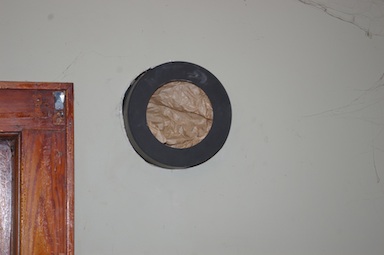May 1, 2012
Who voted in 2011, by party and district
The 2011 Dryden election results startled me. Partly it was the 3-2 Democratic majority, and partly it was the Democratic victories in so many election districts. The final results moderated things a tiny bit, with Republicans reclaiming their utterly solid District 3 by a few votes through absentee ballots, but overall, it was still pretty smashing.
| 2011 Dryden Supervisor Final Results | |||
|---|---|---|---|
| District | Description | Schickel | Sumner |
| 1 | West Dryden | 163 | 185 |
| 2 | Freeville area | 206 | 185 |
| 3 | McLean | 40 | 36 |
| 4 | Varna | 59 | 236 |
| 5 | Etna | 93 | 111 |
| 6 | Village of Dryden | 212 | 199 |
| 7 | E and N of Dryden | 249 | 177 |
| 8 | Snyder Hill, Rt 79 | 84 | 376 |
| 9 | Ellis Hollow Creek | 73 | 389 |
| 10 | South Central | 177 | 210 |
| 11 | Dryden Lake | 185 | 219 |
| Total | 1541 | 2323 | |
The part that puzzled me most, though, was the results in Districts 10 and 11. The southeastern corner of the Town is not exactly friendly territory for Democrats, but we carried both districts by substantial margins. That made me wonder how many Republican voters had crossed party lines. I knew of a few who'd told me they did, but was it really a trend?
The Board of Elections voter data does report who voted in which election. Obviously, it doesn't tell you who voted which way, but you can get a sense of how many people of which parties voted in each district.
| 2011 Voters by Party by District | |||||
|---|---|---|---|---|---|
| District | Description | Dem + Green + WF | Rep + Con | Blank, Ind, Other | Total |
| 1 | West Dryden | 127 | 119 | 101 | 347 |
| 2 | Freeville area | 138 | 181 | 78 | 397 |
| 3 | McLean | 28 | 32 | 15 | 75 |
| 4 | Varna | 181 | 67 | 45 | 293 |
| 5 | Etna | 92 | 66 | 44 | 202 |
| 6 | Village of Dryden | 139 | 196 | 75 | 410 |
| 7 | E and N of Dryden | 161 | 193 | 75 | 429 |
| 8 | Snyder Hill, Rt 79 | 268 | 87 | 109 | 464 |
| 9 | Ellis Hollow Creek | 311 | 76 | 74 | 461 |
| 10 | South Central | 157 | 152 | 85 | 394 |
| 11 | Dryden Lake | 146 | 176 | 83 | 405 |
| Total | 1748 | 1345 | 784 | 3877 | |
I combined the totals for Democrats, Working Families, and Greens, as well as for Republicans and Conservatives, and also Blank, Independence, and Other. It's not a perfect combination, but it makes the math possible.
Next, I compared the vote totals by party to the candidate tallies. (This isn't perfect - 19 people left this line blank, and I think that means I'm missing six people, likely voters who were around for the election but moved afterward.)
| Candidate performance compared to party registration | |||
|---|---|---|---|
| District | Description | Schickel | Sumner |
| 1 | West Dryden | +44 | +58 |
| 2 | Freeville area | +25 | +47 |
| 3 | McLean | +8 | +8 |
| 4 | Varna | -8 | +55 |
| 5 | Etna | +27 | +19 |
| 6 | Village of Dryden | +16 | +60 |
| 7 | E and N of Dryden | +56 | +16 |
| 8 | Snyder Hill, Rt 79 | -3 | +108 |
| 9 | Ellis Hollow Creek | -3 | +78 |
| 10 | South Central | +25 | +53 |
| 11 | Dryden Lake | +9 | +73 |
| Total | +196 | +575 | |
Sumner outperformed a raw bet based on party affiliation pretty drastically, but the district-by-district totals are especially interesting. By this score, Schickel outperformed Sumner in only two districts: Dryden 5, Etna, and Dryden 7, the east side of the Village of Dryden to the Virgil line. Sumner outperformed Schickel drastically in the southwest, districts 4, 8, and 9, but that wasn't a big surprise given past history.
The places that really surprised me were, again, the southeast: Districts 10 and especially 11. District 2, Freeville, also saw some outperformance.
Although the result in 11 doesn't go quite so far that I can state categorically that Republicans voted for Democratic candidates there, it's still shocking when 176 Republicans and 146 Democrats vote, and the result total is 185-219.
My guess is that although the southwest corner of Dryden was ready as usual to vote Democratic, residents of Districts 10, 11, and maybe 2 felt their neighborhoods threatened enough by the prospect of fracking to shift their usual voting patterns.
(I started this analysis a while ago, but never got around to publishing it.)
Turnout by party, 2011
Answer one question, get asked another.
Was it just turnout? Did Democrats show up at the polls, while Republicans stayed home? Definitely not.
| Turnout in 2011 Dryden election, by party grouping | |||||
|---|---|---|---|---|---|
| District | Description | Dem + Green + WF | Rep + Con | Blank, Ind, Other | Total |
| 1 | West Dryden | 35.4% | 37.4% | 29.6% | 34.1% |
| 2 | Freeville area | 50.5% | 53.6% | 33.1% | 46.9% |
| 3 | McLean | 38.9% | 38.6% | 20.8% | 33.0% |
| 4 | Varna | 48.7% | 42.4% | 23.4% | 40.6% |
| 5 | Etna | 46.5% | 46.5% | 27.3% | 40.3% |
| 6 | Village of Dryden | 53.9% | 60.7% | 39.3% | 53.1% |
| 7 | E and N of Dryden | 51.8% | 55.0% | 30.6% | 47.3% |
| 8 | Snyder Hill, Rt 79 | 55.8% | 45.8% | 45.2% | 50.9% |
| 9 | Ellis Hollow Creek | 62.3% | 51.7% | 40.9% | 55.7% |
| 10 | South Central | 59.5% | 58.9% | 40.7% | 53.9% |
| 11 | Dryden Lake | 59.3% | 60.3% | 42.1% | 55.1% |
| Total | 52.5% | 51.7% | 34.6% | 47.3% | |
The further south or east you went, the more people turned out, and people enrolled in a specific party came out more frequently than those registered Blank, Independence, or other. Overall, though, if you'd given me these turnout numbers for a local election without giving me the rest of the story, I'd have forecast a Republican win. Not a sweeping win, but certainly not getting swept!
(I generally expect voters registered Blank, Independence, Other, or Libertarian to tilt significantly Republican in local elections outside of the southwest corner.)
Congressional Candidates Forum video
If, like me, you missed the April 25th forum for the Democratic contenders for the 23rd Congressional District, a complete video is now available. It includes candidates Leslie Danks Burke, Melissa Dobson, and Nathan Shingawa.
Meanwhile, Republican Congressman Tom Reed announced his campaign for re-election.
And if you're still wondering "What's the 23rd Congressional District?", this intro might help.
May 2, 2012
"Enjoy the height of spring"
Cathy Wakeman's Dryden Town Talk explores spring activities.
I'm also curious about which parking lot in Dryden is using these LEDs for light.
Dryden resident and President of the Tompkins County Bar Association Kelly Damm has a guest viewpoint on how "swift justice in courts" is a key "foundation of freedom".
May 4, 2012
Bird walk Sunday
You can find the birds in Dryden's southern hills this Sunday...
Join the Finger Lakes Land Trust on Sunday, May 6 at 8:00 AM for Birds Everywhere!, a bird walk especially for families and children. Join Mark Chao at the Roy H Park Preserve in Dryden for an easy walk through varying habitats. Mark has lots of experience teaching children to bird, and this walk is recommended for young people ages 6 and up. Children must be accompanied by a responsible adult. Please bring binoculars and field guides if you have them and don't forget water and snacks! From Ithaca, take Rt. 13 north to Irish Settlement Rd., turn right and continue 1.5 miles past Hammond Hill Rd. The preserve parking area is on the left just past the southern end of Goodband Rd.
For more information visit our web site at www.fllt.org or call 607-275-9487. This event is free and open to the public and will go rain or shine. M&T Bank is a generous sponsor of this series.
Power plant? What power plant?
The AES Cayuga plant hasn't been running since March, so our electricity is no longer coming from Tompkins County. For more on why, see Stuart Staniford's look at the paths of oil and natural gas prices.
This storm mostly missed our house, though we got lots of rain from the next one through. Here are some pictures from the Dacha Project.
Update: Somehow I missed Henry Kramer's latest bluster about, er, I'm not sure. How valuable it is for the gas industry to spend lots of money pushing its positions, and how we should be grateful to the Ithaca Journal for taking their PR seriously? Something like that.
May 7, 2012
Is Groden in the future?
I'm not guessing that the Towns of Groton and Dryden will merge any time soon, but school districts? Maybe. This article on school budget squeezes notes that the state is pushing consolidation pretty much everywhere.
At TC3, "Associate Professor of Nursing Paula Moore won the award for a new internship that goes along with the college's study abroad program in Nicaragua.... Moore was the only community college faculty member honored, according to the college."
Hollenbeck's Spring Classic Road Race
I spent yesterday morning in Virgil as a corner marshal on the Hollenbeck's Spring Classic Road Race, helping point bicyclists toward their last hill climb and the finish line. (I was volunteering for the Ellis Hollow Preschool - it's not something I normally do.) It's run by the Finger Lakes Cycling Club.
It was great to connect with neighbors Glen and Marcia Swan during the swirl of registration, but I spent most of the time at the intersection of Route 392 and Van Donsel Road.
I'd never seen a large bicycle race before, and it was somewhat different than I'd expected. Riders were crowded at the start, but spread out - some - over the course of the race.
One rider in the first group got off to a major head start and seemed to keep it, pushing the pace car for the group well ahead of the main body of cyclists. Some cyclists stayed in groups, while others moved alone.
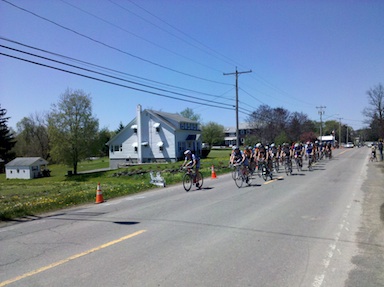
The last big group of cyclists approaches the final hill-climb to the finish.
Racers faced a 22-mile course over Route 392, Parker Street, Clarks Corners Road, Route 221, Babcock Hollow Road, and Owego Hill Road. Some races did one lap, while others did two and the most grueling race did three.
I've posted a gallery of photos if you'd like to see more. (And apologies again - these are all cell phone photos.)
May 8, 2012
Learn from Roscoe
I posted this yesterday at The Albany Project, thinking that it was mainly about state and maybe national issues. There isn't, even in the wildest extremist fever dreams, a political machine in these parts that can compare with the O'Connell/Corning machine in Albany. (Erastus Corning 2nd was Mayor of Albany from 1942 to his death in 1983.)
On reflection, though, Roscoe's lament here is less about the machine specifically and more the perspective of someone justifying his power. I keep hearing echoes of the gas companies' PR in this griping about those utopians, clearly imperfect themselves, who dare challenge a system built on power and avarice.
It's worth contemplating, whatever level or kind of politics you deal with. Learn from Roscoe, but don't become Roscoe.
No, not the how-to of cheating at cockfighting or fixing elections. Roscoe, William Kennedy's 2002 classic of Albany politics, certainly explores all that, but mostly it's a study of a man deeply embedded in a political machine. Roscoe Conway helped build it, profited by it, and now mostly wants to retire - but can't. The machine needs him, for now, even if its participants don't all realize it.
Roscoe is a scoundrel, and even he seems aware of it, though he continues nonetheless. His journey through post-WWII Albany illustrates how the machine works, how it justifies its work, and how the social ties of political relationships sustain it especially when it's under attack.
Roscoe is always thinking about this, but rarely brings it all to the surface. One paragraph, describing a photo of Jimmy Walker, Roscoe, and his comrade-in-the-machine Patsy, though, gives a taste:
This is a war photo: three warriors marching into combat against what Roscoe calls the Morality Plague...
The Plague comes out of oblivion every seven or so years and, like the locust, builds its white houses in public cemeteries, and propagates, with evil simplicity, "truth" and "honesty" as political virtues. This has the popular appeal of chocolate, the distorting capacity of gin.
But Roscoe wonders: Since when has truth been a political virtue? Can you name one truth that is everywhere welcome? Certainly there are none in play in any quest for, or defense of, political power - Jimmy's for instance - for power is based in the deep comprehension and perverse love of deception, especially self-deception, and any man who seeks power through truth is either a fool or a loser.
Roscoe knows of no candidate's ever making a campaign pledge to reveal all his own self-inflation, all those covetous, envious, lascivious, venal, and violent motives that drive every move he ever makes in politics and will continue making if elected. Roscoe certainly did not invent the perverse forces that drive human beings and he can't explain any of them. He believes they are a mystery of nature.
He concedes that a morally pure society, with candidates unblemished by sin and vice, might possibly exist somewhere, though he has never seen or heard of one, and can't really imagine what one would look like. "But I'll keep looking," he concludes. (page 235, paragraph breaks added)
This is a painfully familiar cynicism, echoed in the hallways of power regularly. "We are flawed," it says, and denies that any improvement on those flaws is possible, unless perhaps an impossible utopia springs up. It questions the right of reformers to ask for more of their elected officials. It assumes that the greater knowledge - indeed the cynicism - of those already in power outweighs any possible claims to political virtue of those outside the machine.
Of course, it stands ready to welcome those willing to play its games, and machine politics have a long history of absorbing reformers, turning the last decades's reforming challengers into next year's old guard. Sometimes it can apply its power to defeating reform challengers, and other times it's had to stand aside and wait for the Morality Plague, as Roscoe puts it, to run its course.
Kennedy's Author's Note at the end reminds us that "This is a novel, not history", but like all of his Albany novels, he does an excellent job of capturing a time and a place and a city in ways that usually elude historians. I didn't read Roscoe expecting biographies of Mayor Corning or Dan O'Connell, and I wonder if they experienced quite as much drama as Kennedy presents here. Perhaps.
Roscoe's lessons aren't limited to Albany the city, either. They still apply today - minus many of the exciting period details - to Albany the state capital. Somehow I wasn't surprised to find Assemblyman Jack McEneny listed in the acknowledgments. After all, beyond his interest in history, a decade after Roscoe was written, he was the Assembly's face on LATFOR, continuing a long tradition of selling out the voters in favor of privileging those already on the inside through creative redistricting.
Roscoe has a lot to teach us reformers. Read it, weep, and know your opponent. It took me years to make myself finally read it. It was worth it.
May 9, 2012
School board candidates, Happenin' in the Hamlet, AES maneuvers
The Ithaca Journal has a Meet the Dryden School Board Candidates set of articles from Paul Lutwak, Bill Harding, and Lawrence Lyon. There are three candidates running for four slots, so I'm guessing someone out there will be elected through a write-in.
Groton Town Talk notes McLean's Happenin' in the Hamlet festival, which is coming this weekend.
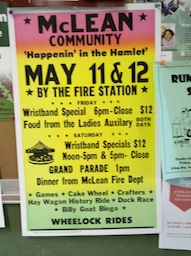
Happenin' in the Hamlet, coming this weekend. (Poster at Dryden Community Center Cafe)
Finally, there's an article on legislation to keep AES Cayuga open, preserving the Lansing coal power plant that produced most of Dryden's electricity until this March. The proposal, which has the NYS Power Authority buy relatively high-priced coal electricity for distribution at low cost, doesn't really add up to me, though I'm also not convinced that the current crash in natural gas prices will last forever. My guess is that this is more Senator Nozzolio's gesture toward Lansing than an effort likely to succeed.
Update: Stuart Staniford's take on the power plant seems about right.
Republicans revolt against their own
Via One of Nine, I see that Congressman Richard Hanna, who currently represents Dryden but whose district drops us in January, has a challenger, Mike Kicinski, who claims to be "The Real Republican and Conservative."
Similarly, and more practically for Dryden, since the district will still include us, Senator Jim Seward has a challenger from his right, James Blake.
May 15, 2012
Primitive Pursuits Day coming up
4-H Acres is one of my favorite things about Dryden, and Primitive Pursuits Day is guaranteed to be interesting:
11th Annual Primitive Pursuits Day
Saturday May 26, 10:00am-4:00pm
at 4-H Acres, 418 Lower Creek Road, IthacaEnjoy old time music by local bands while wilderness skills instructors from across Central New York offer hands-on wilderness survival and outdoor living skills workshops and activities for kids and adults. Activities scheduled throughout the day include flint-knapping, friction fire, guided tree ID walks, tracking walks, basket-making, games, and much more! Events go on RAIN or SHINE! - we have covered space in case of wet weather. Music by Sunny Weather, Steve Selin and Friends, Curt Osgood & Friends, Luke Gustafson, Uncle Joe & the Rose Bud Ramblers! Cost: $10/person or $20-$30 per family suggested donation - all are welcome and none will be turned away! For more information, contact Primitive Pursuits at Cornell Cooperative Extension of Tompkins County, (607) 272-2292.
School elections today
Live in the Dryden Central School District? Polls are open from 7:00am to 9:00pm at the Dryden High School-Middle School on Route 38 between the Villages of Dryden and Freeville. You can find budget information here (PDF). Three candidates are running for four slots, so write-ins matter.
In the Ithaca School District, four people are running for three seats. Polls open at noon, and the budget information is here. Here's a quick summary of where to vote, though you may want to check the map to be certain which district you're in:
If you normally vote in District 8 at Bethel Grove Church Activities Center (1749 Slaterville Road), you vote at Belle Sherman Annex (Mitchell and Cornell Streets., Ithaca).
If you normally vote in District 9, Ellis Hollow, at the Varna Community Center, you vote at Caroline Elementary School, 2439 Slaterville Road (Route 79).
If you normally vote in District 4, Varna, at the Varna Community Center (943 Dryden Rd), you still vote at the Varna Community Center.
If you normally vote in Districts 1 and 5 at the Etna Fire Station, you vote at Northeast Elementary School, Winthrop Drive, Ithaca.
As always, it's complicated.
May 16, 2012
School budgets pass
The Ithaca Journal reports that Dryden's school budget, purchase of three school buses, and a new roof for the Freeville school passed. Bill Harding, Paul Lutwak, and Lawrence Lyon, the listed candidates, won three-year terms, while write-in Brian June won the remainder of a term.
Ithaca's school budget and capital reserve proposition passed, and candidates Sean Bradwell, Jay True, and Eldred Harris won seats on the board.
Organic pest control discussion tonight
Tonight, at 6:30pm the Dryden Community Center Cafe, you can learn about Organic Pest Management for the Home Garden. The poster tells it much better than I can, and you can click on it if you want to see a larger version.

Organic pest control meeting, sign at Dryden Community Center Cafe.
Looking for more to do? Check out Cathy Wakeman's Dryden Town Talk.
Local snake drops in
I'm trying to get back to what I call "Dawn Patrol Gardening", where I take advantage of the early sunrise and cool temperatures to get garden work done. (The dew is less pleasant.)
I was carrying a bag of compost when I thought I felt something fall. It turned out I'd moved someone's bed, and he wasn't very happy with me.
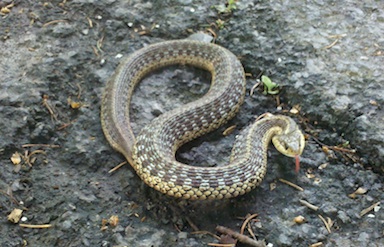
Snake looks up, none too happy.
The pictures aren't great because they're cell phone pictures - the best camera is the one you have with you. Still, this little snake (probably two feet long, and a common garter snake) found an army of friends on Facebook this morning, so I thought he was worth sharing here. I suspect he moved on to a more stable bed.
As for me, I kept working on the hillside by the road. It's steep enough that everything there is twice as tiring as usual, and it was infested with bedstraw. At least I got (most of) the bedstraw out before it flowered and set seed, unlike last year, when it was a giant ugly mat over the (also invasive) goutweed that fills most of that space.
May 17, 2012
A real accident and a simulation
The Ithaca Journal reports on a three-car accident on Route 13 and Etna Road (Etna Lane?), that happened at about the same time emergency crews were demonstrating a response to a simulated DWI accident at Dryden High School.
Update: More details in the updated story.
Varna Community Development Plan meeting May 23rd
It sounds like this is nearing completion:
Public Meeting about the Final Varna Community Development Plan:
The Town of Dryden invites you to the Varna Community Center on May 23 at 7:00PM to review the Final Varna Community Development Plan. We look forward to seeing you there!
When: May 23 @ 7:00PM
Where: Varna Community Center | 943 Dryden Road | Ithaca, NY.
May 18, 2012
Town Board approves Yellow Barn water district
Last night's Town Board meeting started out with a pretty full room, because of the public hearing on the Yellow Barn water district. The Town will be taking over the infrastructure of the Yellow Barn Water Company, whose board members were there to support the project. If residents want a referendum, they can petition for one in the next thirty days, but that room seemed pretty enthusiastic.
Evan Carpenter discussed the formation of an agriculture committee, wanting to make clear that it was "not a mouthpiece for Bruno Schickel, Republicans, or fracking", and that they'd sought out people with different opinions. Board members Jason Leifer and Steve Stelick both sounded enthusiastic about the work so far.
The board also introduced the proposed zoning, a revised subdivision law, and proposed critical environmental areas 1, 2, and 5. I need to catch up on the details of all of those, though my understanding is that the content of the zoning hasn't changed since their earlier decision to delay.
At the end of the meeting, Earthjustice attorney Deborah Goldberg, who will be representing the town pro bono spoke briefly with the board about the future of the Anschutz lawsuit. I foolishly didn't take notes, but the short version is that it will likely be a very drawn-out process with occasional bursts of intense action.
Bolton Point water safer than reported
If, like me, you get your water from the Bolton Point plant, this may come as a mild relief: the water only has 58 parts per billion of trihalomethanes, not the 82 ppb they reported in their water quality report. 80 is the legal limit, and the chemical is a side effect of chlorination.
May 20, 2012
Really? They did? Who knew?
The Dryden Safe Energy Coalition held an informational meeting in Owego, New York, this week.
See? Energy in Depth is good for something - helping me keep track of what a supposedly Dryden organization is doing in other counties! (They don't post such things on their own website. Odd.)
Update: Wondering who Energy in Depth is? More here.
May 21, 2012
Under the Surface
I was a bit cautious about Under the Surface: Fracking, Fortunes, and the Fate of the Marcellus Shale. Tom Wilber's Shale Gas Review blog is always written in cautious journalistese, and to be honest a background writing for Gannett (owner of the Ithaca Journal, Elmira Star-Gazette, and Binghamton Press & Sun-Bulletin) worries me. The company's policy seems to be that sounding objective is always more important than being objective, though at least Wilber had departed before (or perhaps as part of) the last few rounds of their local news decimation.
I underestimated Wilber, though. Under the Surface achieves something better than the usual journalistic "and that's the way it is" or "he said, she said". Wilber's own voice comes through regularly to explain the big picture, and sometimes to explain his participation in a conversation or event, but most of the book is told through other people's voices. Perhaps most important, he chose a diverse enough group of voices that the book manages to avoid a simple pro- and anti-fracking polarization.
The divide is there, and it grows over the course of the book, but he doesn't start there. By starting before fracking became an intense political issue and following a few key groups of people over time, he presents a much more complex and useful story. It's not clear at the beginning which way many participants will go, or how strongly. There are some major surprises in there, and enough sympathetic characters that many points of view can come across well.
Whether you're a fracking opponent or a supporter, you should be able to find sympathetic characters in the book. I doubt Henry Kramer would read this book the same way that I did, and that's probably a good thing. I don't see the farmers trying to decide the future of their land or people trying to figure out how to survive in a place with contaminated water as villains.
There are two groups of characters, however, who generally come off looking terrible: the gas companies themselves and the regulators. In the case of the gas companies, it seems like they don't have much interest in being liked over the long term. At best they try to be nice at the beginning of the process, while they're courting people for leases, but the rest of their story is pretty completely about power. Perhaps there are readers more sympathetic to those with power who will find them positive characters - but I doubt it.
The regulators may come off even worse than the gas companies. It's less that they're personally evil, but more that they largely fail to do their job. Bureaucratic basics like record-keeping are missing from the beginning, and lost or impossible to get information is a regular theme. Overwhelmed agencies that issue permits they can't possibly keep track of can only stay sympathetic for a little while. At the top of the regulatory chain, Pennsylvania Department of Environmental Protection (DEP) Secretary John Hanger comes off as a weird bitter mix of wanting to do the right thing and not actually doing much. In New York, the Department of Environmental Conservation Division of Mineral Resources staff seem almost a part of the industry, with only leadership pushing for regulation with teeth. Even that leadership, though, wobbles around from position to position as they navigate (or fail to navigate in Pete Grannis' case) the politics.
It's a difficult book to read in many ways. Part of the challenge was that I kept shaking my head while reading and had to pause for occasional cursing. My aging web-centric eyes wished that type was a bit larger and the paragraphs broken into smaller chunks, but those are minor flaws. (It's also weird to open the book at the Glenwood Pines and nothing that they didn't eat or drink there, but I'll blame patron geologist of the Marcellus Shale Terry Engelder for that and not Wilber, who was his guest that day.)
Also, in something that may be a relief for Dryden residents: the book doesn't tell our story. Its focus is further south, from Elmira to Deposit in New York State and mostly around Dimock in Pennsylvania, with some excursions elsewhere. There's mention of home rule and bans near the end, but no discussion of Anschutz, Tom West, or Dryden itself. Everything here is relevant, of course, to our story, but sometimes it's good to step back a little bit and see what's happening elsewhere.
Where does all this leave me? Well, first of all it leaves me happy that I'm on the north side of the border, in New York, rather than the state where I was born and went to college, Pennsylvania. As messed up as we are, reading about the Pennsylvania experience left me severely depressed. When Terry Engelder says:
The people in Dimock have already done that, in spades. It's their sacrifice, hopefully, that is necessary if the gas industry continues to evolve and help other people...
Yeah, that pretty much kills me. That's not how you're supposed to conduct experiments, and the gas industry's claims that nothing serious happened in Dimock make it a few thousand times worse.
At the same time, as much as I'd like to see a total ban that would spare the Southern Tier any chance of these disasters coming north, the stories in the book point to some kind of possible if difficult middle ground. The pieces are there - home rule legislation at the municipal level, pressure on the DEC to actively regulate and contain the gas companies, and some landowner coalitions whose proposed terms for leases sound more restrictive (and useful) than what the DEC itself had proposed.
Perhaps most important is something Wilber only mentions near the end: collapsed prices for natural gas and the stronger appeal of Utica Shale deposits further west that also contain far more valuable oil. While gas companies may still be eager to recover their sunken investments in leases in New York, drilling wells at a loss doesn't make long-term sense. That economic collapse may take the pressure off New York for a while, and let us figure out how to deal with this in a saner way.
If you can spare time to read 231 pages, whatever your take on gas drilling, you absolutely must read Under the Surface. I got my copy at Buffalo Street Books, where they still had a small stack of signed copies. It's also available online at a lot of places and I suspect (hope!) it's in our local libraries.
May 23, 2012
The pros and cons of unmasking commenters
I see that the New York State Legislature, or at least a few members, are proposing a ban on anonymous comments on blogs, newspaper comments, and similar things. As this site runs out of my house with a server in downtown Ithaca, I'd definitely have to change my policies here.
The bill itself is fairly readable, if you want to take a look.
Overall, I'm not thrilled about the legislation. I have very mixed feelings about anonymity on the Internet:
On the downside, anonymity gives jerks of every kind the opportunity to hassle other people without consequences.
In a world where the consequences for taking a stand can be drastic, and where organizations of every kind indulge in crazed efforts to suppress information that doesn't mesh with their PR story, there absolutely needs to be an outlet for anonymous speech.
There's also a huge group of people in the middle who have something useful to say but aren't thrilled about handing over their name and address to everyone who might disagree.
The bill itself feels to me like it comes from a group of powerful people who want to shut down speech that might be dangerous to them. Yes, there could be a positive impact on reducing the number of cyber-bullies of all kinds, but the cost to useful political conversation seems far too great. I won't be surprised if this passes, given a climate in Albany that includes for example the Governor's office assembling dossiers on a reporter they considered too critical. It seems like an excellent tool for keeping information under the control of a few powerbrokers with an interest in maintaining New York's gross dysfunction.
via Slashdot.
May 24, 2012
It doesn't have to be old growth to be interesting
A few month ago I overheard a conversation about how nothing much in Dryden was really natural area worth preserving because the forest that previously covered most of the town had been cut down, and what we had left was secondary or even tertiary forest. What valuable could be left in old eroded pastures that no one cared about enough to keep under the plow?
I grew up surrounded by similar forests in Corning, and always found things worth looking for, so maybe I'm just corrupted by too much familiarity with our forests.
Other folks, though, find the regrown forests interesting in their own right. There's a great series of articles this week on the Harvard Forest, 3500 acres of former farmland that's been intensively studied since 1907. Yes, it's in Massachusetts, and not precisely the same landscape, but I run into their research regularly when reading about forests and a lot of it is comparable.
Take a look - we can learn a lot even from land that isn't pristine.
May 25, 2012
Discussing the Varna Master Plan
The Town of Dryden Planning Department returned to the Varna Community Center Wednesday with an update on the proposed master plan for the hamlet. Unlike last November's event, which was loosely structured and focused on what different parts of the hamlet might look like eventually, this was more of a formal talk detailing the process so far and the proposed results.
The simplest - useful, but probably too simple - way to look at it is by comparing the existing conditions map to the proposed map:
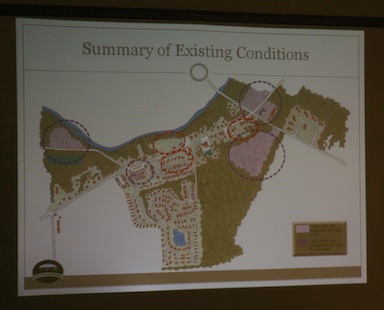
Existing conditions in Varna, with potential (re)development areas marked.
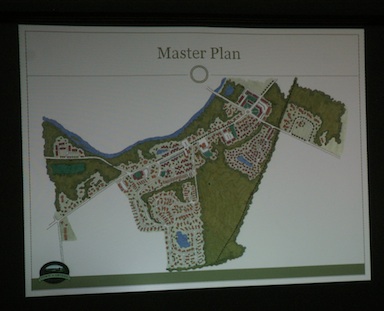
Proposed long-term buildout of (re)development areas.
Consistent with their November presentation, they showed a dramatic proposed increase in density for the hamlet overall, though (I hope) perhaps a manageable one.
The Town isn't, of course, planning to build this themselves - these are possibilities that zoning would allow. The Town examined existing development, traffic, infrastructure, and community issues, and assembled a broad plan that includes zoning language and design guidelines.
Discussion seemed dominated by developer Steve Lucente, who seemed surprised that the Town's approach wasn't exactly like his approach. "Who do you see living there?" was his opening question. It's not a bad question, but it's not really up to the Town to specify demographics like income levels and likely employment for people who live in an area. Town Supervisor Mary Ann Sumner pointed out that it would be seen as controversial "social engineering" if the Town went beyond the traditional municipal considerations of infrastructure and land use.
There were a lot of other, I think more fruitful, conversations. A resident of Hillside Acres was concerned about what development on the edge of the park along Route 366 might mean for current residents of that area, and Chip Ray suggested both that he could include them in his plans and that the state regulations on mobile home parks require him to consider their future.
Jim Skaley suggested that working on changes to the road and near the road, like sidewalks, could make an immediate impact, and also pointed out that the Ithaca School District's decision a few years ago to send children from the area to Caroline Elementary School doesn't exactly encourage families to live here.
Jan Morgan asked about crosswalks in particular, something Varna clearly needs, and Planner Jane Nicholson said that they were in the plan but not in her talk.
Erica Evans worried about the traffic impact. Dan Kwasnowski said it was an important part of their study, and that he hoped to create a slightly slower flow on Route 366 and better flow from Freese and Mount Pleasant Roads. A roundabout there sounded possible, but a traffic light was unlikely.
There are a few properties near the corner of Freese and 366 that are in foreclosure, and it sounded like that might be a place where change happens quickly. We'll see. I've always liked "the blue house" on the corner, but suspect it won't be around forever.
I've also posted a gallery of pictures, which is mostly the slides. I suspect the Town will post a much clearer version of those eventually.
May 26, 2012
Wood stove, Part I
When I first looked at this house, there was a woodstove in the livingroom. It belonged to the tenants, and they were willing to sell it - but my ex-wife was allergic to wood smoke and really didn't want a wood stove in the house. It went, and the only reminder of it was a board over a hole in the wall that we eventually replaced with new sheetrock.
After a few years, it was clear that the wood stove had been the only way to keep heating costs sane in this largely uninsulated house with an inefficient octopus furnace. Prior residents seem to have thought the same.
We cut our natural gas use by about 60% by replacing the furnace with a new one and insulating the house. A few years later, I replaced the aging water heater with a new on-demand heater, and our bills dropped again. I did install a gas cooktop in 2006, replacing an ancient and beautiful but barely functional electric stove, so there's been one fairly small new use of natural gas added to the house while I've been here.
There are a few problems even with the new setup, however:
We need electricity for the furnace, hot water heater, and cooking. Sure, they're gas, but they also need electricity. (Well, yes, I can light the stove with matches if needed, but I don't think the stove will keep pipes from freezing, at least not safely.) I've had fewer power outages at the house for the past few years, but when I moved in, power went out a few times a year. It also seems that we've been luckier with weather than points a little further south, and I'm not counting on that to continue.
The hot water sometimes goes cold in the middle of a shower. Why? Because the hot water heater draws a lot of gas when it's running - and if the heat or the stove are on, it wants to draw more gas than the current connection provides. For our safety, it shuts down. I did call NYSEG about getting a bigger line (or replacing the meter, which may be the limiting factor), but I'm not really enthusiastic about adding gas-consumption capacity to the house, even for short bursts. We haven't expanded the line.
The furnace and the water heater are complex electronic devices. I'd like to think that the parts warehouses will hold their components forever, but based on prior repairs of electronics in appliances, I have my doubts.
I had hoped a few years ago that solar might be an answer, and it probably will be eventually as I slowly clear trees away from my house, but the early tests for hot water and electricity from my roof weren't promising.
Instead, inspired a bit by our recent acquisition of woodland, we're going to install a woodstove. The woodstove we've chosen - which I first saw at Town Supervisor Mary Ann Sumner's house - is a Waterford Stanley cookstove that can also heat hot running water. (Mary Ann didn't go for the hot running water option years ago.) On a sentimental note, Waterford Stanley's stove factory isn't far from the area where my mother's family came from.
This choice is somewhat complicating, as only one place sells these, and it's in Ohio. I didn't find most of our local wood stove installers very excited about working with a stove they didn't sell. (Of course, given the difficulties I've had getting contractors to call me back, some of them may not even have reached that point.)
Fortunately, the folks at Holy Smoke Stove Fireplace and Chimney were familiar with the stove - the owner of the company has one in his house. They were fine with installing it, and enthusiastic about stoves that provide water and cooking as well as heat. They also were willing (for a small extra fee) to take delivery of the 800-pound package.
(In the past I've had tractor trailers deliver to the Orchid Place (formerly Boxcar) parking lot, and then I've carried things up my driveway. While the folks at The Duke Company were willing to rent me a forklift for this, they also wisely asked me about my driveway - which isn't nearly as smooth as the forklift would like.)
It doesn't look like much yet, but the stove arrived a couple of weeks ago. (We're still waiting for the hot water component, which would be a lot easier to install before the stove goes in.)
We're putting the stove, despite its cooking powers, in the same place where the previous wood stove was in the living room, using the chimney that's already on the front of the house. This is a somewhat complicated location because the front door is right there, but the distances work out. It might be nice to put it in the kitchen, and using the chimney there, which seems to have been the original (1929-195?) configuration of the house, but that would mean ripping out and rebuilding the kitchen. I'd like to do that, but it's far too large a project for our funds, and I'm not sure that doing it while the kids are 2 and 4 is a great idea. Maybe eventually we'll move it.
Jared and Jesse came yesterday to work on the connection to the chimney. They worked from the inside of the house, cutting, drilling, and breaking a new hole to the chimney, and installing a thimble. It's a little higher than the old connection, but it all went smoothly.
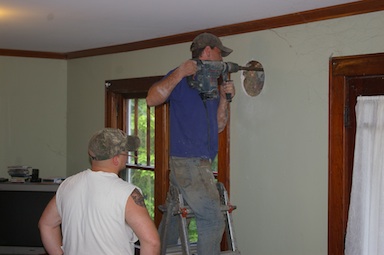
Jesse cuts the hole for the thimble.
There's still a lot more to do. They'll be installing a stainless steel liner in the chimney, something I had doubts was necessary but seems to help with our slightly too complicated stovepipe plan. We still need to install a hearth to go under the stove, and we've picked out stone at Tile-Tec for that. Once the hearth and liner are in, we can move on to the stove itself and the connections to the chimney. Finally, we'll need to connect the hot running water piece to the plumbing.
(The water from the stove will still run through our on-demand gas water heater, which won't turn on if the water coming into it is already hot. In summer, when the stove is likely off, the gas heater will likely do the work until we can get a solar hot water heater installed.)
I'm not planning to rip out my natural gas infrastructure any time soon, but hope that adding the stove will reduce our consumption by about another two-thirds, and break our dependency on electricity and gas to keep the house functioning.
I've also posted a gallery of images of the installation so far.
More to come!
May 28, 2012
Emerald Ash Borer on the way
Area forests, including the trees around my own house, are going to change a lot with the 'imminent' arrival of the Emerald Ash Borer:
Though discovered in New York state, the bugs haven't been found in Tompkins County, according to Whitmore. "It will get here, there's no question about that, and we're not stopping it," he said.
I'm curious about the blue ash trees that are supposedly more resistant, and I may try planting them as replacement trees when it's time.
